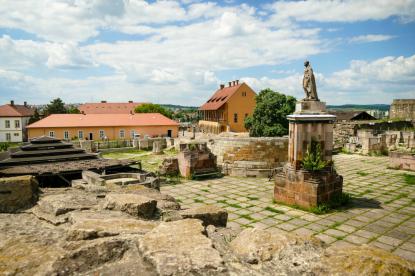2024. November 21. Thursday
István Dobó Museum - Eger
|
|
Address: 3300, Eger Vár 1.
Phone number: (36) 312-744
E-mail: varmuzeum@egrivar.hu
Opening hours: Castle: 07.11-28.02.: Mon-Sun 9-18, 01.03-06.11.: Mon-Sun 9-22
Exhibitions: 07.11-28.02.: Tue-Sun 10-16, 01.03-06.11.: Mon-Sun 10-18 |
Museum tickets, service costs:
|
Individual ticket for adults
|
2000 HUF
|
|
|
Individual ticket for adults
|
1000 HUF
|
|
|
Individual ticket for students
|
1000 HUF
|
|
|
Individual ticket for pensioners
|
500 HUF
|
|
|
Individual combined ticket for adults
(István Dobó Museum + Géza Gárdonyi Memorial Museum)
|
2400 HUF
|
|
|
Individual combined ticket for students
(István Dobó Museum + Géza Gárdonyi Memorial Museum)
|
1200 HUF
|
|
|
Individual combined ticket for students
(István Dobó Museum + Géza Gárdonyi Memorial Museum + Sándor Ziffer Gallery)
|
1400 HUF
|
|
|
Individual combined ticket for pensioners
(István Dobó Museum + Géza Gárdonyi Memorial Museum)
|
1200 HUF
|
|
|
Individual combined ticket for pensioners
(István Dobó Museum + Géza Gárdonyi Memorial Museum + Sándor Ziffer Gallery)
|
1400 HUF
|
|
|
Individual combined season ticket for a year for adults
(István Dobó Museum + Géza Gárdonyi Memorial Museum + Sándor Ziffer Gallery)
|
2800 HUF
|
|
|
Group guide for adults
|
500 HUF
|
/ capita
|
|
Group guide for students
|
300 HUF
|
/ capita
|
|
Group guide for pensioners
|
300 HUF
|
/ capita
|
|
Group guide
|
6000 HUF
|
/ group
|
|
Group guide
|
12000 HUF
|
/ group
|
|
Individual wedding photographs
|
12000 HUF
|
The Eger Bishopric was founded by Saint Stephen between 1001 and 1009. The Cathedral, consecrated in the name of Saint John, was built on the castle hill during the 11th and 12th centuries and became the final resting place of, among others, King Emerich I.

In the middle of the 14th century the Cathedral underwent a significant gothic style reconstruction. Chapels were built on the two sides of the Cathedral and its walls were reinforced by buttresses. Plans were made for a monumental, three-aisled cathedral with a new chancel, an encircling aisle and a ring of chapels, the east side of which was completed by the end of the century. In its size and architectural design it would have competed with any European cathedral of the era, but unfortunately its construction was interrupted because of a change in foreign political conditions. In 1506 it was struck by lightning, which caused a huge fire, so its further construction was permanently halted. After Buda was occupied by the Ottoman forces, the reinforcement of the castle became a priority. Consequently the Cathedral’s gothic style chancel was converted into a bastion in 1542.
As you walk from the Ruin Garden towards the Dark Gate you can see the Rotunda, which is perhaps the most important architectural remain of Eger’s early history. The round chapel was destroyed by church constructions and modernisations, but its foundation walls mostly remained in place. The Rotunda, which was approximately seven metres in diameter, was part of the Bishop’s mansion that stood here at the time. Unfortunately, only the chapel’s south side arch survived, as well as a few wall portions of the northeast wall arch. The archeological excavations revealed a constructed tomb with a stone plate cover, which didn’t contain skeletal remains, but its location and the head support found in the tomb suggest that a high ranking church dignitary was buried here.

In the middle of the 14th century the Cathedral underwent a significant gothic style reconstruction. Chapels were built on the two sides of the Cathedral and its walls were reinforced by buttresses. Plans were made for a monumental, three-aisled cathedral with a new chancel, an encircling aisle and a ring of chapels, the east side of which was completed by the end of the century. In its size and architectural design it would have competed with any European cathedral of the era, but unfortunately its construction was interrupted because of a change in foreign political conditions. In 1506 it was struck by lightning, which caused a huge fire, so its further construction was permanently halted. After Buda was occupied by the Ottoman forces, the reinforcement of the castle became a priority. Consequently the Cathedral’s gothic style chancel was converted into a bastion in 1542.
As you walk from the Ruin Garden towards the Dark Gate you can see the Rotunda, which is perhaps the most important architectural remain of Eger’s early history. The round chapel was destroyed by church constructions and modernisations, but its foundation walls mostly remained in place. The Rotunda, which was approximately seven metres in diameter, was part of the Bishop’s mansion that stood here at the time. Unfortunately, only the chapel’s south side arch survived, as well as a few wall portions of the northeast wall arch. The archeological excavations revealed a constructed tomb with a stone plate cover, which didn’t contain skeletal remains, but its location and the head support found in the tomb suggest that a high ranking church dignitary was buried here.
